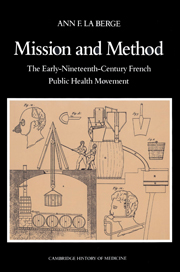Book contents
- Frontmatter
- Contents
- List of tables and illustrations
- Preface
- Acknowledgments
- Introduction
- I Community, method, context
- II Carrying out the mission: Institutionalization, investigation, moralization, and practical reform
- Chapter 4 Institutionalization: The health councils
- Chapter 5 Investigation and moralization: Occupational hygiene and industrialization
- Chapter 6 Investigation and practical reform: Public health in Paris
- Chapter 7 Public health in Paris: Investigation, salubrity, and social welfare
- III Public health before Pasteur
- Epilogue
- Appendixes
- Bibliographical Note
- Index
Chapter 7 - Public health in Paris: Investigation, salubrity, and social welfare
Published online by Cambridge University Press: 17 September 2009
- Frontmatter
- Contents
- List of tables and illustrations
- Preface
- Acknowledgments
- Introduction
- I Community, method, context
- II Carrying out the mission: Institutionalization, investigation, moralization, and practical reform
- Chapter 4 Institutionalization: The health councils
- Chapter 5 Investigation and moralization: Occupational hygiene and industrialization
- Chapter 6 Investigation and practical reform: Public health in Paris
- Chapter 7 Public health in Paris: Investigation, salubrity, and social welfare
- III Public health before Pasteur
- Epilogue
- Appendixes
- Bibliographical Note
- Index
Summary
Sanitary reform included much more than improving water and sewer systems. The salubrity of private dwellings and public establishments, such as hospitals and prisons, was critical to the healthfulness of Paris. Personal cleanliness and the purity of food and drink were also areas of major hygienic concern. The scope of early-nineteenth-century public health interests was so broad that hygienists also considered social welfare concerns part of their domain. Indeed, many of these problems were intimately related to public health. In their dual concern over morals and health, hygienists investigated prostitution, which they considered the primary cause of venereal disease. Because of the high infant mortality rate, they also took an interest in the wet-nursing business and the foundling question. Many of these problems had earlier been handled by charitable institutions and would in the second half of the century fall into the domain of social welfare or public assistance, but in the early nineteenth century they were public health problems.
THE SALUBRITY OF PRIVATE DWELLINGS
Claude Lachaise, physician and author of the principal medical topography of Paris, presented a report to the Royal Academy of Medicine in 1840 that described the influence of crowded living conditions on urban mortality. Lachaise noted that although there had been many public health reforms in Paris since 1815, improvements in private dwellings were negligible. Construction had not kept pace with the population increase, and new dwellings were small and badly built. Many Parisians lived in substandard, unsanitary dwellings.
- Type
- Chapter
- Information
- Mission and MethodThe Early Nineteenth-Century French Public Health Movement, pp. 241 - 280Publisher: Cambridge University PressPrint publication year: 1992



